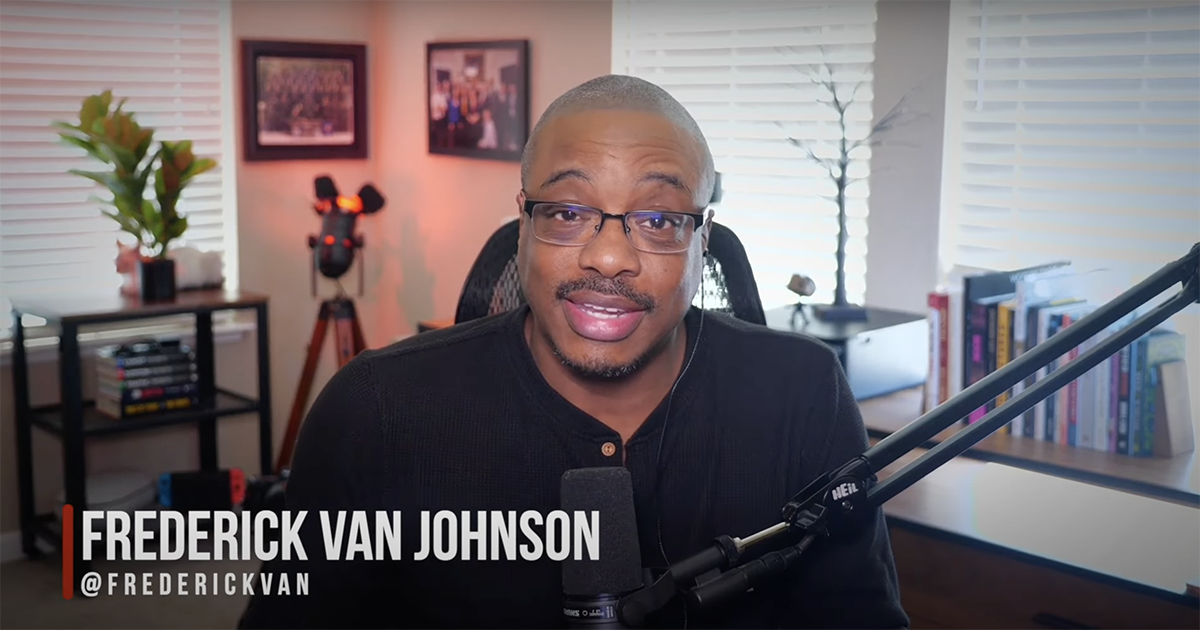
TL;DR
- The mobile creator lifestyle isn’t just for influencers and Gen Z.
- Specialization is all well and good, but it’s important to be adaptable and to identify the right medium to best tell a story.
- Frederick Van Johnson thinks a mobile-friendly workflow can improve your craft while also making your content more relatable. Learn more at the NAB Show New York Photo+Video Lab session, “The Mobile Creator Lifestyle: Your Studio on the Go.”
Frederick Van Johnson is a photographer and podcaster who says that the main throughline of his work is content creation. He says he is now the kind of “storyteller where you kind of reach for the tools that best let you tell that particular story, whether it be a still photograph, or cinemagraph, or video, or audio or text or whatever.”
He also advocates for a version of work that is attainable for most people. And Van Johnson does so from the perspective that it will improve your work product, not just your lifestyle.
Watch our interview with Van Johnson broken into two installments (embedded below).
Van Johnson is probably best known for his This Week in Photo podcast, which he’s been making for more than a decade. It began as an audio-only venture, but Van Johnson says they added the video element when Google introduced Hangouts (RIP).
“Why not just do it live, kind of like those radio stations, where they have the camera in the studio?” Van Johnson remembers. “You know, like Howard Stern or whatever, they’ll have the camera in the studio, and you know that it’s being recorded for radio, but you get to be a fly on the wall in there.”
The subject of his podcast was an additional incentive; it’s easier to talk about photography when you can reference an image your audience can also see. It’s also easier as an interviewer to be “able to connect with someone visually, making eye contact, seeing those visual cues,” which he says then “helps you tailor what you’re going to say.”
Ultimately, Van Johnson says, “I think being able to connect that way with the person I’m interviewing, it just takes it to that next level.”
Listeners became viewers, and when Google sunset Hangouts, Van Johnson knew they couldn’t kill this element of TWiP. “That led us down the road of different tools, and things to try,” he says.
Tell the Story
Adaptability is a hallmark of success for modern creatives, and Van Johnson thinks experimentation helps keep him on the top of his game, or to put it another way, change gets his “creative river flowing.”
Van Johnson does understand the temptation to specialize, but he prefers to think of projects in terms of stories and to identify the correct tools to tell it accordingly.
Speaking of tools, he thinks it’s important to remember what your audience cares about. Hint: it’s not about the process. “Other photographers want to know how the sausage is made. The person that you’re creating the sausage for just wants to eat it, right? They just want to see the work.”
Put another way: “They just want you to tell the story. And if the story is provocative enough so that they get excited about looking at that thing, then who cares how it was made? Who cares how you get there? You made it, and you touch them in some way. Now they’re excited about your work.”
The Right Tool for the Right Job
As a creative working in multiple formats, Van Johnson understands the advantages and challenges of choosing not to specialize. But, he says, “In today’s world, especially considering where things seem to be going right now, it pays you to be that ‘stereotypical lifelong learner,’ where you’re always taking in new data and adjusting and kind of rolling with it.”
And some of that new data comes from reviewing tech specs. For example, cinematic HD became more accessible as camera form factors decreased and prices dropped. Van Johnson recalls an inspiring conversation with Vincent Laforet, who specializes in aerial photography and cinematography, that gave Van Johnson his light bulb moment.
“We are image makers, so yeah, of course, we can apply the knowledge that we’ve learned about light as a photographer, just at 30 frames a second now and tell stories narratively,” he says.
“Again, it’s the right tool for the right job. So still photography… is an unmatched art form. But there are other art forms that are another mechanism to share your creative voice that are popping up, like vertical video, like TikTok … folks do themselves a disservice by saying ‘no, I’m a still photographer; live video [is] for those video guys.’ Well, surprise, you are a video guy.”
And video itself is evolving. Augmented reality, virtual reality, and 360⁰ video are all increasingly accessible.
New Mobile Ways of Working
Van Johnson also thinks creatives should be open to new ways of working.
“We don’t have to be chained to these offices anymore. I think that’s what the mobile creator lifestyle is all about. It’s cutting that cord and moving the mindset from even the word home office, right?” Van Johnson says.
“I think the medium that we’re playing in doesn’t need to play by their rules. We can be anywhere,” Van Johnson says. He adds, “I think being mobile gives us the flexibility and the power to be more relatable.”
Perhaps the best part is “The tools are literally telling you as a creator, ‘you now have more power in your hand, go do something with it,’” Van Johnson says.
Specifically, he says, “With Apple and the M1 and M2 processors, software like Luma, fusion and DaVinci Resolve on the iPad for for editing. There’s a million audio tools, photography, tools, AI tools, all this stuff on these mobile devices, that when configured properly, with the proper peripherals, you can replicate what you have here in your home studio, but have the ability to just go pop off and go to you know, Mexico or something, find a strong internet connection and get to work and keep creating.”
Not everyone may be prepared to take that leap, but Van Johnson encourages us to find new ways to make our workflows more mobile friendly.
Step one, he says, is to reconsider cloud-based tools (if you haven’t already).
“Those softwares or service applications have in many ways, some in some cases surpass their, quote,’ real application’ counterparts, Van Johnson says. “So I would suggest that those folks start looking at it from that perspective… of what can I replace?… The more that you can get done in the browser, the more you are free from your desktop.”
If you’re already working in the cloud, he suggests, “If you have an established workflow, start incorporating next generation tools into that established workflow.”
By that, Van Johnson means, “try to get it done on a tablet and see where the holes are? See where the barriers are? … A limitation of the hardware and software or are they a limitation of, you know, your gray matter, right, which means you can overcome that and learn how to do things that way.”
After all, Van Johnson says, “You may be surprised. Some things will will likely feel easier” on mobile.


